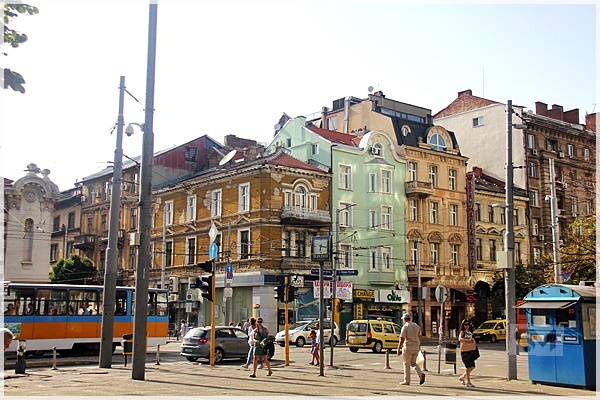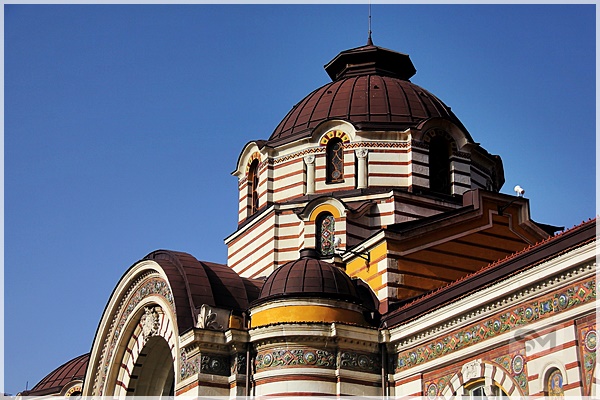Masih lagi berada di Sofia, ibukota Bulgaria.
Sofia (София) is the capital of Bulgaria. It is also the biggest city in the country with about 1.7 million citizens (including suburbs). Today, Sofia is a dynamic Eastern European capital, distinguished by its unique combination of European and Communist-style architecture as well as many beautiful orthodox churches.
Sofia was founded 2,500 years ago. Over the centuries, it has been given several names - Serdica , Sredetz and the remains of the old cities can still be viewed today. Because of its strategic location in the middle of Balkans for a while it had been selected for a new capital of the Roman Empire. Near Sofia is the Boyana church, one of the most valuable memorials of Bulgarian and European culture. The church has frescoes, acclaimed by specialists as “the best examples of Eastern medieval art during its twelve century history”.
The decline of Sofia during the Turkish Ottoman Empire was followed by the rejuvenation after the Russian liberation in 1878, when Sofia was chosen as the capital of Bulgaria at the First National Constituent Assembly, and followed by a brisk and straight-forward period of construction.
Sofia
Statue of Sveta Sofia. Di ibaratkan sebagai penjaga kota Sofia
Bangunan di Sofia
Oleh kerana Sofia ni kota lama maka banyak khazanah warisan bandar terdahulu dipulihara dan kekal di celah celah pembangunan masa kini.
Antaranya adalah ...
Sveta Petka - Small, unassuming orthodox church made of stone & filled with many ancient biblical murals.
Di sini juga terletaknya Complex Ancient Serdica. Kota lama yang masih dikekalkan sebagai warisan sejarah di sini.
Kat bawah di bahagian basement ada banyak kedai kedai jual cenderamata tapi harga jauh berbeza dengan kedai yang aku usha awal awal tadi dekat Vitosha Boulevard terutamanya FM. Sini lagi mahal padahal tak de ramai pelanggan pun.
Tak jauh dari situ ada Banya Bashi - Ornate mosque with a large dome built over thermal spas during the 16th-century Ottoman Empire.
Sedang elok, aku ke sana sebab boleh solat. Kalau nasib baik mesti ada kedai halal di kawasan kawasan ni.
Banya Bashi Mosque
Cathedral Church Sveta Nedelya yang aku singgah masuk sebentar tadi kelihatan dari situ.
Aku singgah nak solat dulu di masjid ni.
Sejarahnya...
Banya Bashi Mosque (Bulgarian: Баня баши джамия, Banya bashi dzhamiya; Turkish: Banya Başı Camii) is a mosque in Sofia, Bulgaria, built by the architect and civil engineer Mimar Sinan.
Its construction was completed in 1566, during the years the Ottomans had control of the city. The mosque derives its name from the phrase Banya Bashi, which means many baths. The most outstanding feature of the mosque is that it was actually built over natural thermal spas; one can even see the steam rising from vents in the ground near the mosque walls. The mosque is famous for its large dome, diameter 15m, and the minaret.
Currently, the Banya Bashi Mosque is the only functioning mosque in Sofia, a remnant of the Ottoman rule of Bulgaria that lasted nearly five centuries, and is used by the city's Muslim community.
Jom masuk !
Jemput masuk
Tempat wuduk. Bersih dan terjaga
Dewan solat utama
Kubah
Ruang solat
Interior
Ada ruangan tingkat atas untuk jemaah
Masa aku solat tu nampak ada dua tiga orang lah. Tapi dia orang tak de lah tegur aku pun dan aku pun buat tak tau apa jugak. Solat dan kemudian beredar.
Perkarangan masjid Banya Bashi
Cari cari jugak kot ada kedai halal ke kat area tu tapi macam tak nampak je. Pastu tetiba kat situ ada orang bergaduh. Laki pompuan, yang pompuan menjerit jerit yang lelaki dok pukul pukul. Ntah masalah apa agaknya. So malas masuk campur aku blah je.
Tsentralni Hali - The Central Sofia Market Hall, known popularly simply as The Market Hall is a covered market in the centre of Sofia, the capital of Bulgaria, located on Marie Louise Boulevard
Kawasan sekitar
Masjid tadi tu terletak di kawasan taman kecik dan di bahagian belakangnya ada bangunan cukup ikonik yang di kenali sebagai The Sofia Public Mineral Baths.
The Sofia Public Mineral Baths
The Central Mineral Baths (Централна минерална баня, Tsentralna mineralna banya) is a landmark in the centre of Sofia, the capital of Bulgaria, a city known for the mineral springs in the area.
It was built in the early 20th century near the former Turkish bath (then destroyed) and was used as the city's public baths until 1986.
Bangunan ini pernah musnah semasa Perang Dunia ke 2 dan dibaikpulih semula.
Sebahagian daripada bangunan ini kini di jadikan Sofia Regional Historical Museum since September 2015
Dari kawasan tu aku menapak lagi. Dan jumpa bangunan kerajaan yang di kenali sebagai Former Communist Party House.
The Largo - architectural ensemble of three Socialist Classicism
Landmark yang terletak bersebelahan dengan President's Office
The former Communist Party House /Bulgarian: Partien Dom/ is now used by the National Assembly of Bulgaria. Today the building is mainly used as Government offices and the splendid Sofia Hall is occasionally used for charity concerts.
The light-coloured neo-classical edifice lies at the end of the Independence Square, but it is the evidence how former Communism leaders in Bulgaria made their effort to follow the whole Communism concept and establish a grandiose building with the intention to house the Communist Party central Committee. The impressive building, now one of top Sofia’s landmarks, was designed by a team of prominent architects. It was completed in 1955. In order to represent the Communism in Bulgaria, a massive red star crowned the rocket-shaped spire of the building. However, when Bulgarians attempted to torch the building in 1990, the star was removed in a hasty manner. Subsequently the red star was substituted by the flag of Bulgaria.
Berdekatan dengan kawasan ni memang banyak bangunan bangunan kerajaan.
Bangunan Councils of Ministers
Sofia Statue kelihatan dari persimpangan
President's Office. Ramai je yang tumpang bergambar kat sini.
Guardsmen depan main entrance
Actually aku patut pegi ke Church of St. George, Sofia yang terletak kat belakang President's Office dan perkarangan Sofia Hotel Balkan tu tapi aku terlupa. Ralit berjalan sedar sedar dan ke arah lain. Malas lah nak patah balik.
National Archaeology Museum
Bulgaria Hall tempat konsert diadakan.
National Art Gallery
Ada orang jual jualan
National Art Gallery, Sofia
National museum for Bulgarian artworks from the Middle Ages to the present, in former royal palace.
The National Art Gallery (Bulgarian: Национална художествена галерия, Natsionalna hudozhestvena galeriya) is Bulgaria's national gallery and houses over 50,000 pieces of Bulgarian art. It is located on Battenberg Square in the capital city of Sofia, occupying most of the historic and imposing edifice of the former royal palace of Bulgaria, having been established in 1934 and moved to the palace in 1946, after the abolition of the monarchy. National Art Gallery is situated at an altitude of 556 m
Dan berhadapan dengan National Art Gallery adalah City Garden.
City Garden of Sofia. Originating in 1872, this scenic park with a fountain & flowerbeds is a popular spot to play chess.
Water fountain
Jualan di kawasan City Garden
Ramai jugak orang melepak lepak di kawasan park ni.
The City Garden (Bulgarian: Градска градина, Gradska gradina) is Sofia, the capital of Bulgaria's oldest and most central public garden, in existence since 1872.
The City Garden (Bulgarian: Градска градина, Gradska gradina) is Sofia, the capital of Bulgaria's oldest and most central public garden, in existence since 1872.
It is located between Tsar Osvoboditel Boulevard to the north, Knyaz Alexander Battenberg Street to the west and Joseph Vladimirovich Gourko Street to the south, in the historical centre of the city.
Dari City Garden tersebut akan nampak Ivan Vazov National Theatre
Imposing neoclassical theater, opened in 1907, home to a diverse program of stage productions.
The Ivan Vazov National Theatre (Bulgarian: Народен театър „Иван Вазов“, Naroden teatar „Ivan Vazov“) is Bulgaria's national theatre, as well as the oldest and most authoritative theatre in the country and one of the important landmarks of Sofia, the capital of Bulgaria. It is located in the centre of the city, with the facade facing the City Garden.
Founded in 1904 by the artists from the Salza i Smyah company, it was initially called simply the National Theatre, but before being named after the prominent writer Ivan Vazov it also bore the name of Krastyu Sarafov between 1952 and 1962.
Masa aku kat situ macam ada acara. Banyak kerusi dan khemah sedang di susun atur.
So aku lepak jap makan aiskerim.
Sambil usha awek Bulgaria ni mundar mandir. Kejap ke kanan kejap ke kiri. Busy sungguh.
Dah abis berehat sebentar kat situ, aku sambung berjalan.
Hari dah petang
Church of St Nicholas the Miracle-Maker atau dikenali sebagai Russian Church.
1914 Russian Orthodox church featuring a colorful tiled exterior & gilded onion domes.
The Russian Church ([Руска църква, Ruska tsarkva] error: {{lang-xx}}: text has italic markup (help)), officially known as the Church of St Nicholas the Miracle-Maker (църква "Св. Николай Чудотворец", tsarkva "Sv. Nikolay Chudotvorets"), is a Russian Orthodox church in central Sofia, Bulgaria, situated on Tsar Osvoboditel Boulevard.
Tapi sebab macam dah tutup so aku tak de lah pegi usha dekat dekat dan masuk ke dalam.
Teruskan berjalan
Dan sampai di persimpangan. Ada statue ni. Tsar Osvoboditel - Built in 1903, this imposing monument of the Russian emperor on horseback sits in the city center.
National Assembly of the Republic of Bulgaria
Library of Bulgarian Academy of Sciences
Dan dari situ ada jalan terus menuju ke tempat yang menjadi destinasi paling penting dan paling aku nak tengok di kota Sofia ni.
Cathedral Saint Alexandar Nevski - Iconic Bulgarian Orthodox church with Neo-Byzantine architecture & an underground museum.
Tapi nampak dari jauh macam tak de orang. Jangan jangan dah tutup !! Jauh aku datang ni nak tengok bangunan ni.
* ikat tali kasut dan memecut laju................
bersambung....................
























































haha, skrg dah kena ikat tali kasut
ReplyDeletetu lah. yang jadi lagi teruk. kaki kettik kassut.
Deletecedera tak leh nak melangkah lebih padu
tq
ReplyDelete